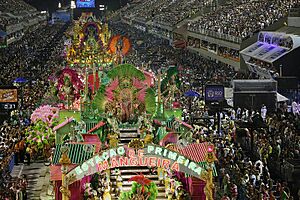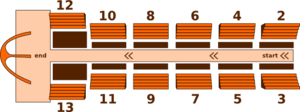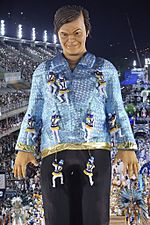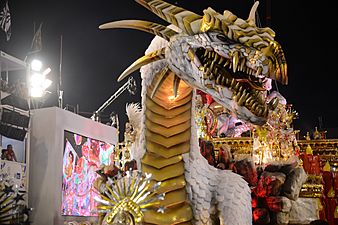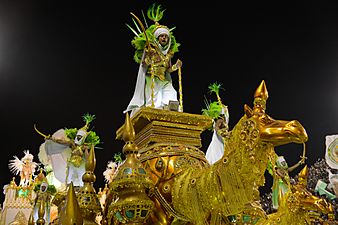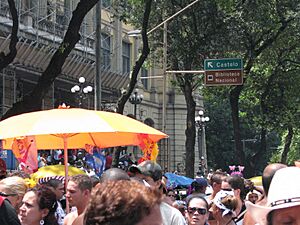Rio Carnival facts for kids
Quick facts for kids Rio Carnival |
|
|---|---|

A float at Rio Carnival, 2014
|
|
| Type | cultural, religious |
| Significance | Celebration prior to fasting season of Lent. |
| Celebrations | Parades, parties, open-air performances |
| Begins | Friday before Ash Wednesday (51 days to Easter) |
| Ends | Ash Wednesday noon (46 days before Easter) |
| 2024 date | Afternoon, February 9 – midday, February 14 |
| 2025 date | Afternoon, February 28 – midday, March 5 |
| 2026 date | Afternoon, February 13 – midday, February 18 |
| 2027 date | Afternoon, February 5 – midday, February 10 |
| Frequency | annual |
| Related to | Carnival, Brazilian Carnival, Ash Wednesday, Lent |
The Rio Carnival (Portuguese: Carnaval do Rio de Janeiro) is a huge yearly festival in Rio, Brazil. It happens just before a religious period called Lent. It is known as the biggest Carnival party in the world, with millions of people joining in! The first Rio Carnival was way back in 1723.
The main event is a parade filled with dancers, amazing floats, and costumes. These come from many different samba schools in Rio. There are over 200 samba schools! A samba school is a group of neighbors who come together to prepare for Carnival. They share a local area and a common background.
Each samba school follows a special order in their parade. It starts with the "comissão de frente" (Front Commission). This group of 10 to 15 people introduces the school. They perform choreographed dances in detailed costumes. These dances often tell a short story. After them comes the first float, called "abre-alas" (Opening Wing). Then come the "Mestre-sala" and "Porta-Bandeira" (Master of Ceremonies and Flag Bearer). They lead the dancers, including older members and the "ala das baianas." At the back is the drum line, sometimes with brass instruments and guitars.
Contents
History of Rio Carnival
The Rio Carnival celebration began around the 1650s. Back then, people held big feasts to honor Greek wine gods. The Romans also worshipped Bacchus, their god of the grape harvest.
The festival 'Entrudo' came from Portugal and inspired Brazil's Carnival. In 1840, Rio held its first masquerade ball. People danced to polka and waltz music. Later, in 1917, African culture brought Samba music to the Carnival. Samba is now a traditional Brazilian music style.
The Carnival was canceled during some war years (1915–1918 and 1940–1945). It was also canceled in 2021 due to the COVID-19 pandemic in Brazil. It returned in 2023.
Samba School Parades
The first samba school parades took place in Praça Onze, also known as “Big Africa.” This area is considered the birthplace of today's Carioca Carnival parade. Famous schools like Estácio de Sá, Portela, and Estação Primeira de Mangueira paraded there in 1929. By 1930, seven schools were active in the city.
Over the years, the parade moved to different avenues. In 1978, it moved to the Marquês de Sapucaí Avenue. It has been held there ever since. In 1983, the governor asked architect Oscar Niemeyer to design a permanent stadium for the parades. Before this, the seating stands were only temporary.
In 1984, the parade was split into two days because it became so long. Lower-level schools paraded on Friday night. The major schools, including the most famous ones, paraded on Sunday night. That year, Mangueira was named "super-champion." This title has not been given since.
The main samba schools, called the Special Group, parade on Sunday and Monday. Other schools parade on Friday and Saturday. The winning school from the Gold Division gets to join the Special Group next year. The Special Group champion parades again on the Saturday after Ash Wednesday.
Carnival Dates
Rio's Carnival starts on the Friday before Lent and ends on Ash Wednesday. However, the Winners' Parade happens on the Saturday after Carnival ends. The top schools from the Special Group and the A Series champion all parade one last time. This parade is a huge show of dance, fashion, music, and competition. Thousands of performers parade through the Sambadrome in the early morning hours. The Sambadrome has seating for 72,500 spectators.
- February 21 to 26, 2020
- February 12 to 17, 2021 (canceled due to COVID-19 pandemic)
- April 20 to April, 2022 (moved due to COVID-19)
- February 17 to 22, 2029
Getting Tickets
The Sambadrome was built in 1984 as the new home for Rio Carnival. Today, many Carnival events require tickets. There are different types of tickets for the Sambadrome:
- Grandstand tickets are general admission. You get seats on a first-come, first-served basis.
- Frisas are open-air box seats right along the samba runway.
- Camarotes are luxury boxes located between the frisas and the grandstands.
- Sector 9 is for tourists. These are like grandstand tickets but with assigned seats.
Ticket prices change based on the type of ticket, the section, and the season. The cheapest sections are 12 and 13. You can buy tickets in advance from international brokers or local travel agents. Usually, you buy a voucher first, which you exchange for the actual ticket closer to the event.
-
Float with a giant Lemuel Gulliver
-
A float with a camel caravan
Street Carnival Parties
While the main parade is at the Sambadrome, many people celebrate at street festivals. These street parties are very popular with locals. They are less fancy than the parades, but still full of music and dancing. Anyone can join in the fun!
Bandas are street bands that are a big part of the street carnival. You just jump in and join the fun. One famous banda is Banda de Ipanema, started in 1965. It's known as Rio's most fun street band.
Dancing and music are key to the Rio Carnival. The most famous dance is Carnival samba. This Brazilian dance has roots in African cultures. Samba is popular not just at Carnival, but also in neighborhoods outside the main cities. These areas help keep the traditional dance alive.
Music is also a huge part of Carnival. Samba Carnival instruments create amazing beats and rhythms. These make the crowd dance in a colorful celebration. The samba style in Rio is called Battucanada. This means the dance and music are based on percussion instruments. It lets people sing, dance, and parade all at once. This is why the batucada style is found in most of Rio's street carnivals.
Street parades, called blocos and bandas, happen all over Rio during Carnival. There can be over 300 bandas happening at once. The biggest street party is usually outside the Sambadrome. The largest organized street dance is often in Cinelândia Square. In 2012, over 2 million people joined the Cordão da Bola Preta bloco.
When the Sambadrome was built in 1984, it moved many street parades downtown to a ticketed area. Since then, some samba schools have worked to bring the carnival tradition back to the streets. Many of these blocos represent a local community but are open to everyone.
Carnival Royalty
King Momo
King Momo is a symbolic king of Carnival. He is chosen to lead the celebrations.
Queens of Carnival
The Queen of the Carnival in Rio de Janeiro and up to two princesses help lead the fun. Unlike some cities, Rio's Carnival Queens do not represent a specific samba school. In competitions, the princesses are usually named 1st and 2nd Princess. Some queens or princesses later become "battery bridesmaids" for samba schools.
|
||||||||||||||||||||||||||||||||||||||||||||||||||||||||||||||||||||||||||||||||||||||||||


